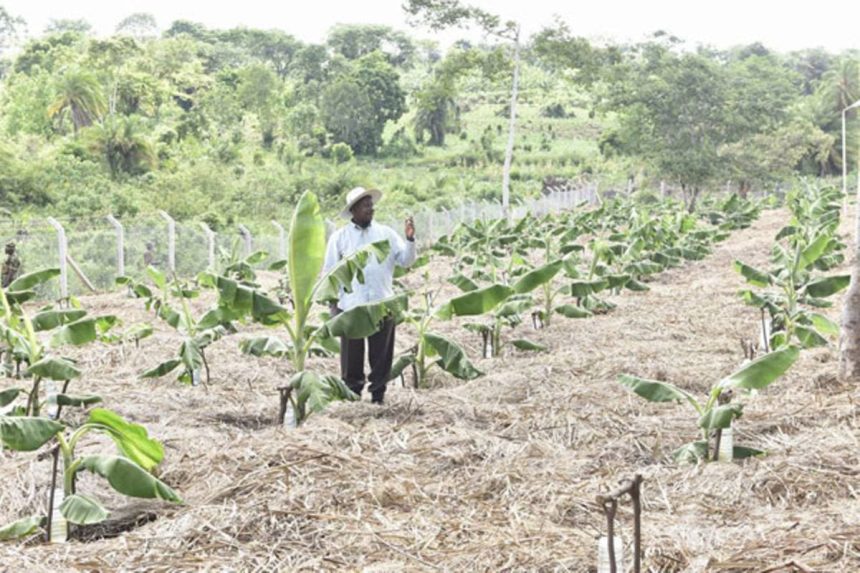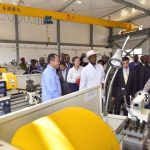Published on 28/10/2025
If agriculture is the backbone of Uganda’s economy, then water is the lifeblood and President Museveni is making sure that lifeblood flows freely, far and wide.
In a bold move that’s set to turn Uganda’s fields from parched to prosperous, the President has pledged massive investment in water for production and irrigation, calling time on the country’s over-reliance on rain-fed farming.

For decades, Ugandan farmers have played roulette with the skies, planting in hope, praying for rain, and watching their dreams dry up when the clouds refused to cooperate. But now, the tide is turning. The National Resistance Movement (NRM) is digging deep, literally and figuratively, to ensure that every farmer, from the hills of Kween to the plains of Karamoja, has access to reliable water sources.

Already, seven large-scale irrigation schemes are up and running like well-oiled machines: Ngenge in Kween, Rwengaaju in Kabarole, Tochi in Oyam, Mubuku II in Kasese, Olweny in Lira, Doho II in Butaleja, and Wadelai in Pakwach. These aren’t just pipes and pumps, they’re lifelines for thousands of farmers who’ve long been at the mercy of the weather.
And the work is far from done. Three more mega-schemes are under construction: Acomai in Bukedea, Atari straddling Kween and Bulambuli, and the expansive Namatala project covering Budaka, Mbale, and Butaleja. These are not just drops in the bucket, they’re strategic strikes against poverty, hunger, and agricultural stagnation.
But the NRM isn’t just thinking big, it’s thinking smart. Solar-powered irrigation systems are lighting up the countryside, empowering smallholder farmers with clean, sustainable water solutions. Over 4,300 micro-scale irrigation facilities and 5,251 small and medium-scale schemes have been rolled out across 135 districts. That’s not just progress, it’s a revolution in boots and gumboots.
From East to West, North to Central, the irrigation map reads like a national heartbeat. In Eastern Uganda, Amagoro and Angololo in Tororo, Sipi in Bulambuli, and Cheptui in Kapchorwa are turning dry patches into green gold. In Karamoja, Namalu in Nakapiripirit and Hopei in Napak are bringing hope to a region long battered by drought.
Northern Uganda is pulsing with new projects: Unyama in Gulu and Amuru, Imvempi in Arua, Purongo in Nwoya, and Palyec in Amuru, all poised to turn dust into harvest.
Western Uganda isn’t left behind either. Kabuyanda dam and irrigation network, Matanda in Kanungu, and Enengo in Rukungiri and Kanungu are laying the groundwork for bumper yields. In Central Uganda, Kawumu in Luweero is rising like a phoenix, promising water security and agricultural revival.
But Museveni’s vision doesn’t stop at crops, it stretches to cattle corridors and conservation zones. Valley dams and tanks have been built in every nook and cranny where livestock roam and wildlife wander. From Kyenshama Dam in Mbarara to Karengese in Nakapiripirit, from Kalopedomuge in Kotido to Katotin in Amudat, the NRM is plugging every leak in Uganda’s water access story.
The list reads like a roll call of transformation: Isingiro, Nakaseke, Gomba, Bukomansimbi, Kiruhura, Kazo, Ntungamo, Rakai, Mubende, Nakasongola, Ibanda, Kyankwanzi, Luweero, Nabilatuk, Kaabong, Karenga, Soroti, Butebo, Kapelebyong, Kumi, Lyantonde, Bugiri, Omoro, Arua, Dokolo, Agago, Kayunga, Mbale, Tororo, Kiryandongo, Nwoya, Kibaale, Sembabule, Kiboga, Katakwi, Kalaki, Masindi, Abim, Kibuku and even the Kidepo Conservation Area in Karenga District, where wildlife now sip from man-made oases.
This is not just infrastructure, it’s insurance against famine, a firewall against climate change, and a springboard for Uganda’s agricultural renaissance. Museveni’s irrigation pledge is a masterstroke, a rainmaker’s promise in a land that’s ready to bloom.
So whether you’re a farmer with a hoe, a herder with a herd, or a youth with a dream, the message is clear: water is coming, and with it, prosperity. The days of waiting on the rain are numbered. Uganda is irrigating its way to abundance, and there’s no turning back.






